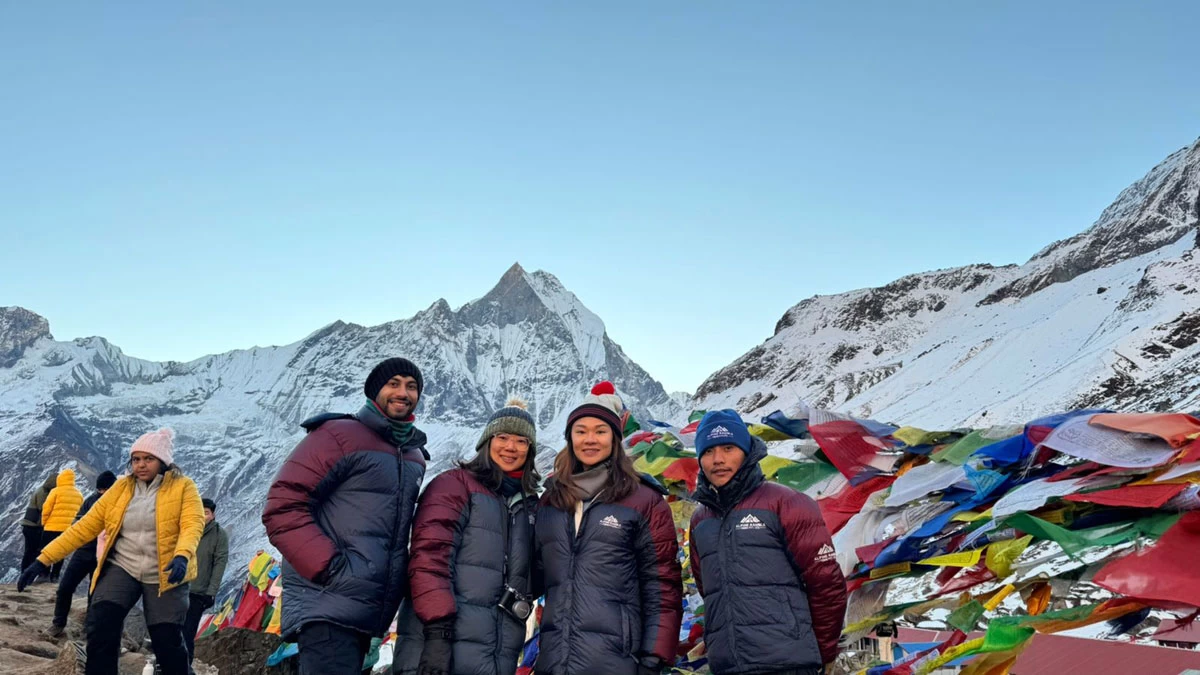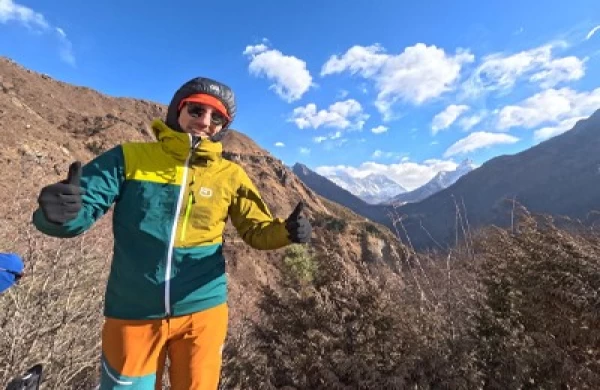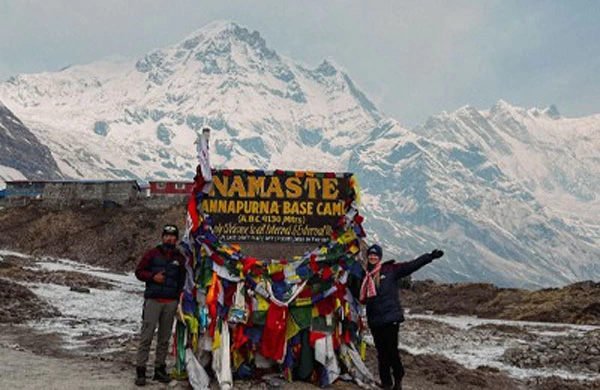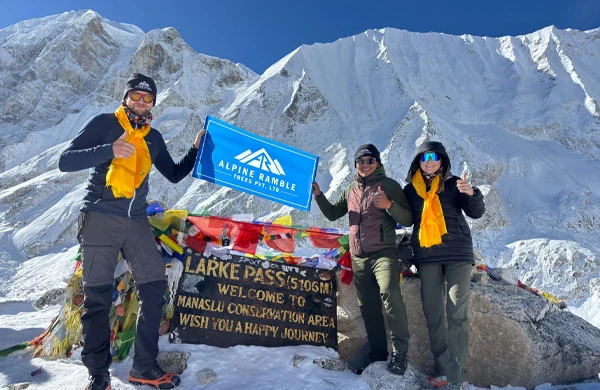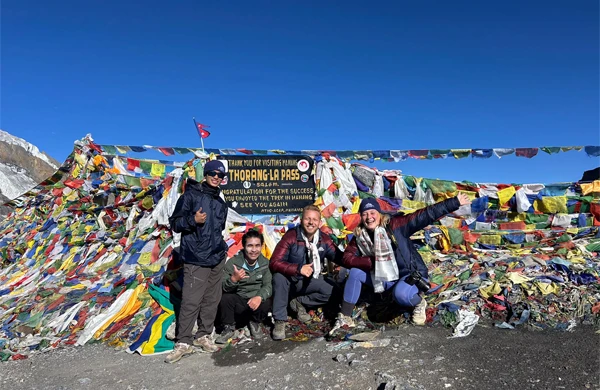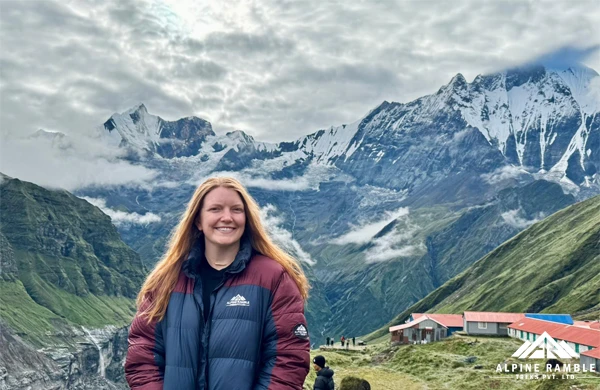Table of Contents
- Why you should do the Annapurna Base Camp Trek in January?
- Easy Access, Short and Sweet Trek
- Peaceful Trail and Less Crowd
- Good Weather and Clear Views
- Winter and New Year Deals
- Elevation, Altitude Sickness, and Acclimatization
- Is it safe for the ABC Trek in January?
- How do I prepare for the Annapurna Base Camp Trek in January?
- Clothes, Gear, and Equipment Packing List
- Accommodation in the Annapurna Base Camp in January
- Guides, Porters, and Permits for the Annapurna Base Camp Trek in January
- Conclusion
The month of January means a new beginning and what better way to start the new year than by embarking on a trekking journey to the Annapurna Base Camp? And you must be wondering, can you do the Annapurna Base Camp Trek in January? Yes! Absolutely! You can do the Annapurna Base Camp Trek in January.
Trekking is one of the most sought-out adventure activities. Especially in Nepal, where there are many places where you can surround yourself with mountains and not only some mountains but the ones that are actually of the tallest in the world. And the Annapurna Base Camp Trek is no exception. But many are skeptical about doing the trek in January or winter overall, thinking that it will not be possible.
The uncertainty regarding trekking to the mountains during the winter season is a valid concern that most people have. Many are unaware that you can actually smoothly trek to many places in Nepal during December, January, and February. You just need to know how to correctly prepare for trekking during the middle of the winter and you should be set to have some of the most memorable trekking experiences of your life!
On this blog, we will give you all the information on trekking to the Annapurna Base Camp in January so that you can efficiently plan your trek during this month. This will be discussed under different sub-topics, which will help you navigate through everything you need to know before you set out for the Annapurna Base Camp Trek in January/
Why you should do the Annapurna Base Camp Trek in January?
The Annapurna Base Camp is one of the most popular trekking destinations in Nepal. Every year, thousands of tourists come here to trek and enjoy the mountain experience. This destination is deemed one of the perfect locations for trekking. Unlike the Everest Base Camp Trek, the Annapurna Base Camp can be done in half the time it takes for the prior one. This trek presents you with the perfect pathway to experience just the right blend of nature, mountains, and the culture of the native communities along the trail.
Easy Access, Short and Sweet Trek
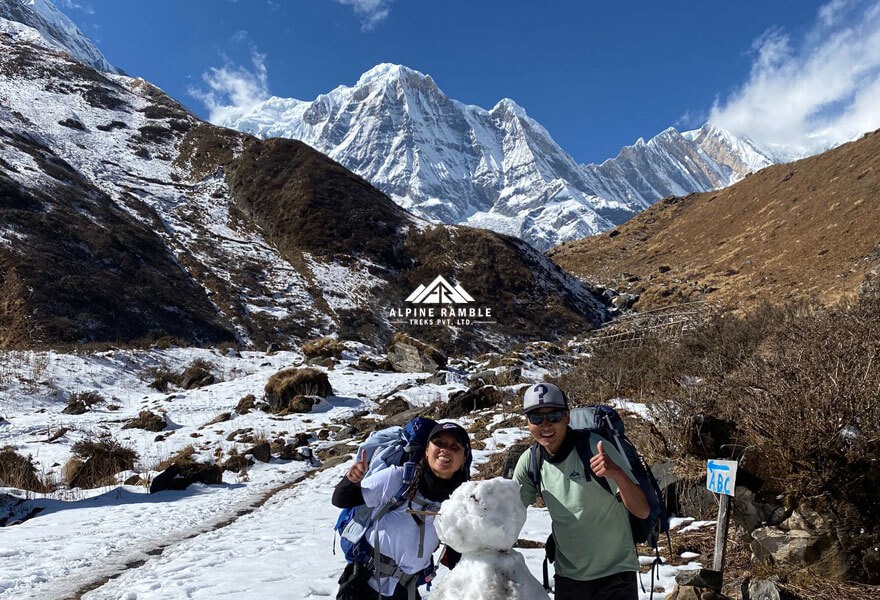
One of the benefits of choosing to trek the Annapurna Region is that you can have a direct flight to Pokhara and after a few hours’ drive, you will be walking on the trekking trail the same day. And it is no different for the Annapurna Base Camp Trek. You can take an early morning flight to Pokhara, which is only half an hour long, then you can catch a Jeep ride to Jhinu Danda and start your trek to the base camp.
And for those who choose not to fly, you can also take a bus to Pokhara but keep in mind that it is an 8–9-hour ride, which will extend an extra day but it is actually the standard itinerary for this trek.
The entire trek can be done within a week, six days to be exact. This just shows how you can complete this trek swiftly with a pleasant experience. In the span of just six days, you will have an amazing window of opportunity to experience the natural beauty of Nepal, along with the gorgeous mountains, unique culture, and landscapes.
Peaceful Trail and Less Crowd
One of the best parts of trekking in January is that you will have the trail to yourself. There are very few people trekking in the Himalayas during the winter season, which makes your journey even better. The trails that normally see hundreds of people going up and down daily will seem vacant and quiet. It is the perfect opportunity to do a spiritual journey, where it will just be you, the mountains, and the lush green forest.
This is just the right time for the people who want to avoid crowded places but still want to experience the true beauty of the Annapurna Base Camp Trek. With fewer people on the trail to disturb you, you will feel a lot closer to nature and mountains.
Good Weather and Clear Views
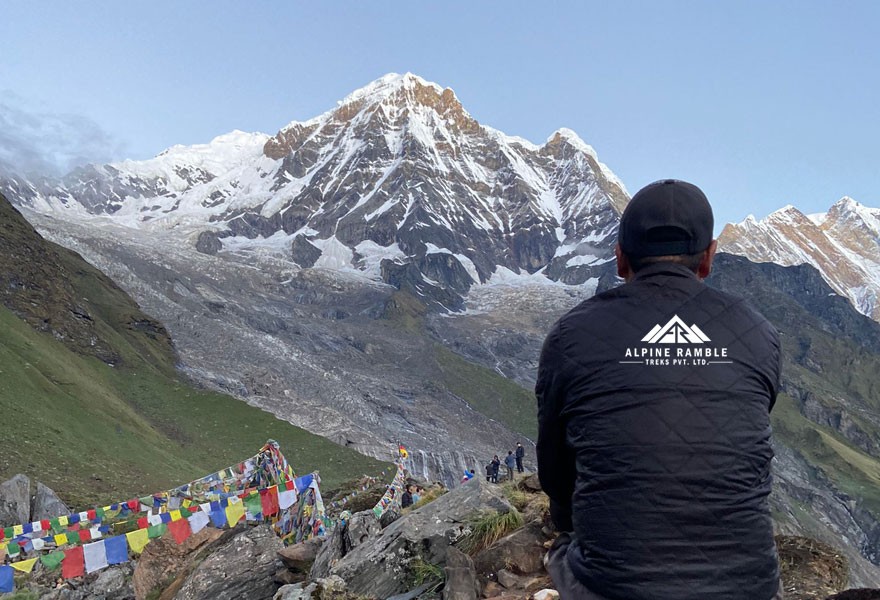
Having good weather is the epitome of the best trekking experience. Imagine embarking on a trek and the weather isn’t clear and you do not get to see the views you trekked so hard for days. You do not have to worry about this happening during January—much. It would be giving you false hope if we said that the weather will always be good and clear, but nature is unpredictable and we cannot guarantee it 100 percent. However, as per the experience of many guides over the year, winter undoubtedly has the best and clearest weather for trekking.
It will be cold as it is the middle of the winter and you can walk on the snow and witness the mesmerizing scenes where the towering peaks are covered with the white fluff. This is the perfect time to see the undisturbed views of the mountains, including Annapurna Massif (Annapurna I-IV), Dhaulagiri, Machhapuchhre, Manaslu, Gangapurna, Tilicho Peak, Pisang Peak, and others.
Winter and New Year Deals
There will be many instances where you might get deals during this time if the companies are offering any. As January falls during the off-season and is also New Year, there might be discount offers; this can even be for flights and accommodation. Be sure to consult with your chosen company regarding this before your journey.
What are the weather and temperatures like in the Annapurna Base Camp Trek during January?
As expected, the temperature at the Annapurna Base Camp Trek during January will be lower than in spring or summer. In fact, it is the coldest month yet so don’t forget to pack winter clothes to keep you warm during the trek. You need to be well informed regarding how the temperature will be and the severity of the cold in the Annapurna Base Camp during this month.
The average temperature during the day can range from 5 to 10 degrees Celsius and -15 to -20 degrees Celsius during the night. Also keep in mind that the higher you ascend, the colder it will be. There will be chances of snowing as well so you need to pack gear suitable for such scenarios.
And as mentioned above, weather in the mountains can sometimes be very unpredictable so you need to be up to date on the patterns and pack accordingly. The nights are always colder, so make sure to keep yourself warm and trust the direction of your guide. But overall, despite the chilling cold, the skies will be clear and ideal for viewing the mountains.
Elevation, Altitude Sickness, and Acclimatization
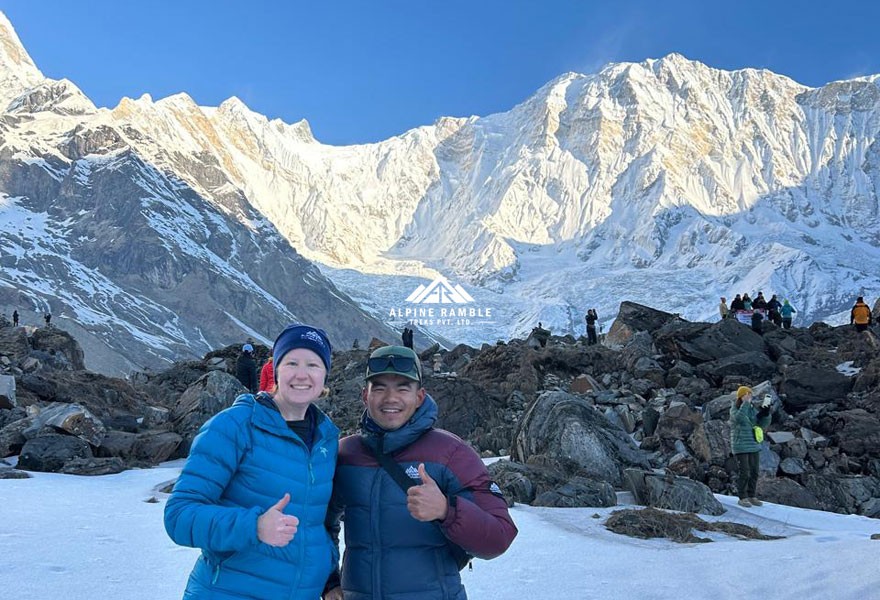
You will gain a significant elevation while doing the Annapurna Base Camp Trek. From Kathmandu to the Base Camp, the lowest altitude will be 830 m/2,713 ft in Pokhara and the highest altitude you will touch is the Annapurna Base Camp itself at 4,130 m/13,550 ft. You will be ascending and gaining a lot of altitude in a single day, which is why you need to be careful about the altitude sickness.
Altitude sickness can happen if your body fails to adjust to the gain in elevation. Some symptoms, such as headaches or weakness, are pretty common, so you just need to make sure to take proper rest, hydrate, and eat a proper diet to feel better. But if the symptoms keep getting worse, then the best option would be to descend down.
Acclimatization is a big part of trekking in the mountains. It is only normal that our bodies will not be used to such high elevation, especially for those who live at sea level. Altitude remains constant no matter which month you are trekking in, so you have to allow your body to acclimate. When it comes to the Annapurna Base Camp Trek, you must follow the standard itinerary and not ascend more than you should just because you can walk that far in a day. It is only inviting trouble for yourself.
Acclimatization is extremely crucial to avoid altitude sickness. You can only enjoy your trek if you are feeling good. Therefore, you need to look after your own health by keeping your body hydrated, eating nutritious food, walking only the recommended elevation and making sure to rest during the trek. You can take medication as directed per your physician, but we recommend acclimating naturally instead of using medication unless you have to.
Is it safe for the ABC Trek in January?
The Annapurna Base Camp is considered generally safe. But take this answer with a grain of salt, as you will be out in the wilderness in the month of January. Your main concern will be cold and snow, as the path might be slippery. Avoid going solo because there is always a chance of losing your way and getting lost. Taking extra steps to make sure you are safe is a good thing.
A huge part of being safe during the trek depends on you. You need to be physically and mentally fit. Be very aware of your surroundings, as many areas are prone to landslides. Pack accordingly so you do not catch a cold and get sick. Hire a professional trekking guide so you can avoid such problems and be safe.
How do I prepare for the Annapurna Base Camp Trek in January?
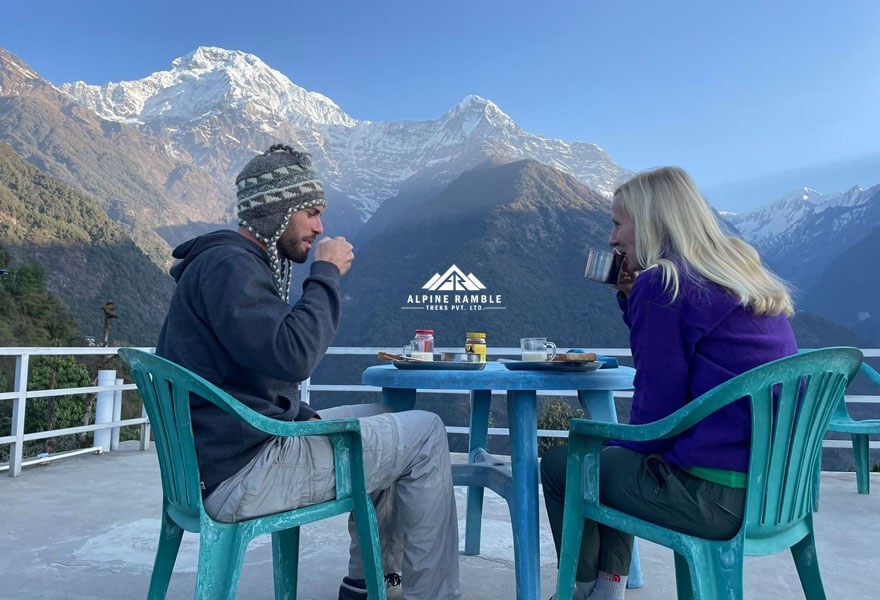
There will be not much change in preparing for the trek in January compared to other months. The only difference is you will have to be extra careful while packing and make sure you have enough clothes to keep you warm in the freezing temperatures. The mountains will be cold 365 days of the year but winter will be even colder, so you should be mentally ready for that.
Being mentally strong gives you the strength to get through any tough situations, and in this case it will be the hours of walking every day, altitude gain, and negative temperatures. And apart from mental toughness, you should also be physically fit to tackle such a feat.
The Annapurna Base Camp Trek falls under moderately challenging trails and can be done by beginner trekkers as well. Being in your peak physical health will make your trekking experience better. And to prepare physically, you must start at least a month prior to your trekking date. Focus on conditioning your cardiovascular system and eat healthy diet food.
Clothes, Gear, and Equipment Packing List
Trekking to the mountains means you should expect cold temperatures. That being said, January is the peak winter and will be even colder compared to other months. So, being appropriately prepared is the best way to ensure not only your health and safety but also a good experience overall. Just imagine being in one of the most beautiful places on earth but you cannot even enjoy it because you are feeling cold because you did not pack enough warm clothes.
There are many layers to the things that are required in the mountains. The first one is the clothes, and you need to make sure you have the right ones that can actually protect you from the harsh cold. From down jackets and wind stoppers to caps and socks, every item matters, especially when you are doing this trek in the middle of the winter. You need knowledge about layering and make a good packing list for trekking to make sure you do not forget the essentials.
The gear and equipment, such as sleeping bags that can withstand temperatures below -20°C, crampons to walk on ice and snow, trekking poles, and many more, are the essential requirements for trekking to the Annapurna Base Camp during January. The easiest way to ensure you have all the items is by doing extensive research on them and making a packing list before you begin your trek.
Accommodation in the Annapurna Base Camp in January
Accommodation on the trails of the Annapurna Base Camp Trek is the standard tea house. The higher you ascend, the more basic the services get. A basic tea house offers a dorm-style room with two beds, a mattress, and blankets. Depending on where you stay, some tea houses do have a single room with an attached bathroom too. But since January is off-season, you will get to pick and choose where you stay and the owners will offer you the best services since they will not have that many guests to attend to.
You can also get Wi-Fi services for extra cost and regarding electricity, the higher part of the trek uses solar power, which might not be as reliable at times and you also need to pay some amount for charging your electronics as well. And as for food, you can get varieties of meal options here. From western food to authentic Nepalese food, you can get what you desire.
Guides, Porters, and Permits for the Annapurna Base Camp Trek in January
Going trekking to the mountains in any part of Nepal requires a registered trekking guide and permits. As per the rule set by the government, you cannot go trekking without hiring a guide. It was done so because many tourists got lost while doing a solo trek. This is for the safety of the trekkers. And especially in winter when higher altitudes have snow covering the path, it is easy to get lost. So, having a trekking guide will not only be helpful in terms of safety, but they will also have in-depth knowledge of the place.
Hiring a porter, however, is up to you. Some agencies give you a porter once you purchase their packages but you need to hire one if that is not the case. For the Annapurna Base Camp Trek, you will need two permits. Since this trek falls under the area of the Annapurna Conservation Area, you will need the Annapurna Conservation Area Project Permit (ACAP Permit) and one for your safety and information known as the Trekkers’ Information Management System (TIMS Card). It is mandatory to have these two permits if you wish to trek to the Annapurna Base Camp.
Conclusion
The Annapurna Base Camp Trek is a spectacular destination where you can experience the glorious mountains of the Annapurna and Dhaulagiri ranges and unique local culture. The ABC trek during January offers you an even more unique perspective. The clear sky and good weather are the perfect time to do this trek. Once you prepare for the winter cold, this trek is going to be a pleasant experience.
This short trek is packed with explosive flavors of nature and communities with white snow to make an unforgettable trip. Doing the Annapurna Base Camp Trek in January is a completely different experience you should not miss out on. You can also do the Everest Base Camp or Poon Hill Trek in January. If you would like to schedule a trek to Annapurna Base Camp in January, you can do so by email or WhatsApp at info@alpineramble.com or +977 9851175531.

